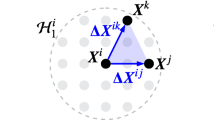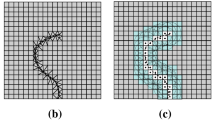Abstract
Phase-field models for crack propagation enable the simulation of complex crack patterns without complex and expensive tracking and remeshing as cracks grow. In the setting without inertia, the crack evolution is obtained from a variational energetic starting point, and leads to an equation for the order parameter coupled to elastostatics. Careful mathematical analysis has shown that this is consistent with the Griffith model for fracture. Recent efforts to include inertia in this formulation have replaced elastostatics by elastodynamics. In this brief note, we examine the elastodynamic augmentation, and find that it effectively causes the Griffith surface energy to depend on the velocity of the crack. That is, considering two identical specimens that are each fractured by a single crack that grows at different velocities in the two specimens, it is expected that the final equilibrium configurations are nominally identical; however, the phase-field fracture models augmented with elastodynamics achieve final configurations—in particular, the Griffiths surface energy contributions—that depend on the crack velocity. The physical reason is that the finite relaxation time for the stresses in the elastodynamic setting enables the cracked region to widen, beyond the value observed in the quasistatic setting. Once the crack widens, the “no-healing” condition prevents it from relaxing even after the specimen reaches equilibrium. In phase-field models, crack width in the reference configuration is unrelated to the physical opening of the crack but is instead a measure of Griffiths surface energy. This observation suggests that elastodynamic phase-field fracture models should not be used in settings where the crack velocity is large.


Similar content being viewed by others
Notes
Note that the crack width in the reference configuration is unrelated to the opening of the crack in the lab / current configuration; rather it is related to the transformation of material particles to the zero-elastic-stiffness second phase.
A phase-field formulation for fracture proposed by Karma et al. (2001) is popular in some fields for fracture calculations. It is not clear if that model has the deficiency noted here, but it has numerous other problems, e.g. noted in Bourdin et al. (2011), and hence we have not examined it further.
References
Abdollahi A, Arias I (2012) Phase-field modeling of crack propagation in piezoelectric and ferroelectric materials with different electromechanical crack conditions. J Mech Phys Solids 60(12):2100–2126
Agrawal V, Dayal K (2015a) A dynamic phase-field model for structural transformations and twinning: regularized interfaces with transparent prescription of complex kinetics and nucleation. Part I: formulation and one-dimensional characterization. J Mech Phys Solids 85:270–290
Agrawal V, Dayal K (2015b) A dynamic phase-field model for structural transformations and twinning: regularized interfaces with transparent prescription of complex kinetics and nucleation. Part II: two-dimensional characterization and boundary kinetics. J Mech Phys Solids 85:291–307
Bourdin B, Francfort GA, Marigo J-J (2000) Numerical experiments in revisited brittle fracture. J Mech Phys Solids 48(4):797–826
Bourdin B, Francfort GA, Marigo J-J (2008) The variational approach to fracture. J Elast 91(1–3):5–148
Beyerlein IJ, Hunter A (2016) Understanding dislocation mechanics at the mesoscale using phase field dislocation dynamics. Philos Trans R Soc A 374(2066):20150166
Bourdin B, Larsen CJ, Richardson CL (2011) A time-discrete model for dynamic fracture based on crack regularization. Int J Fract 168(2):133–143
Bleyer J, Roux-Langlois C, Molinari J-F (2017) Dynamic crack propagation with a variational phase-field model: limiting speed, crack branching and velocity-toughening mechanisms. Int J Fract 204(1):79–100
Clayton JD, Knap J (2011) A phase field model of deformation twinning: nonlinear theory and numerical simulations. Phys D Nonlinear Phenom 240(9):841–858
Francfort GA, Marigo J-J (1998) Revisiting brittle fracture as an energy minimization problem. J Mech Phys Solids 46(8):1319–1342
Freund LB (1998) Dynamic fracture mechanics. Cambridge University Press, Cambridge
Griffith AA (1921) The phenomena of rupture and flow in solids. Philosophical Transactions of the Royal Society of London. Series A, Containing Papers of a Mathematical or Physical Character 221:163–198
Karma A, Kessler DA, Levine H (2001) Phase-field model of mode iii dynamic fracture. Phys Rev Lett 87(4):045501
Lipton R (2014) Dynamic brittle fracture as a small horizon limit of peridynamics. J Elast 117(1):21–50
Lipton R (2016) Cohesive dynamics and brittle fracture. J Elast 124(2):143–191
Li B, Peco C, Millán D, Arias I, Arroyo M (2015) Phase-field modeling and simulation of fracture in brittle materials with strongly anisotropic surface energy. Int J Numer Methods Eng 102(3–4):711–727
Miehe C, Hofacker M, Welschinger F (2010) A phase field model for rate-independent crack propagation: robust algorithmic implementation based on operator splits. Comput Methods Appl Mech Eng 199(45–48):2765–2778
Porta M, Lookman T (2013) Heterogeneity and phase transformation in materials: energy minimization, iterative methods and geometric nonlinearity. Acta Mater 61(14):5311–5340
Rosakis AJ, Ravichandran G (2000) Dynamic failure mechanics. Int J Solids Struct 37(1):331–348
Sagiyama K, Rudraraju S, Garikipati K (2017) A numerical study of branching and stability of solutions to three-dimensional martensitic phase transformations using gradient-regularized, non-convex, finite strain elasticity. arXiv preprint arXiv:1701.04564
Yang L, Dayal K (2010) Formulation of phase-field energies for microstructure in complex crystal structures. Appl Phys Lett 96(8):081916
Zhang L, Chen L-Q, Qiang D (2008) Diffuse-interface description of strain-dominated morphology of critical nuclei in phase transformations. Acta Mater 56(14):3568–3576
Zhang X, Krischok A, Linder C (2016) A variational framework to model diffusion induced large plastic deformation and phase field fracture during initial two-phase lithiation of silicon electrodes. Comput Methods Appl Mech Eng 312:51–77
Acknowledgements
This work draws from the doctoral dissertation of Vaibhav Agrawal at Carnegie Mellon University. We thank Kaushik Bhattacharya for valuable discussions and comments. We acknowledge support from: (1) ARO Numerical Analysis (YI W911NF-12-1-0156 and W911NF-17-1-0084), ONR Applied and Computational Analysis (N00014-14-1-0715) and NSF DMREF Program (1628994); (2) the Department of Mathematics at the University of Bath through the Parkin Visiting Professorship; (3) an appointment to the National Energy Technology Laboratory Faculty Research Participation Program sponsored by the U.S. Department of Energy and administered by the Oak Ridge Institute for Science and Education; and (4) the National Science Foundation through TeraGrid resources provided by Pittsburgh Supercomputing Center.
Author information
Authors and Affiliations
Corresponding author
Appendix: Numerical method and values of parameters
Appendix: Numerical method and values of parameters
In the expression for the energy:
we use \(\eta _\epsilon = 10^{-8}\), \({\mathcal {G}}_c = 0.8\), \(\epsilon = 10^{-4}\), and linear isotropic elasticity is assumed with Lame constants \(\lambda = 10^4\), \(\mu =8 \times 10^3\) in non-dimensionalized units. The mass density is \(10^4\).
The computational domain is a square of size 1. We define the origin at the bottom left corner. As described in the main text, the initial condition includes a notch—at \(x_1=0.5\) running from \(x_2=0\) to \(x_2=0.15\)—to initiate the growth of the crack. A notch is defined here as a region over which \(\phi \eqsim 0\).
Tractions \({{\varvec{t}}}\) are imposed on the left and right boundaries at \(t=0\) to cause tensile elastic waves to initiate and travel towards the center of the domain. The boundary conditions are as follows:
When these waves hit the notch, they cause crack growth to commence. We have used \(P=750\) and \(P=1000\) to get the different crack speeds described in the main document. The displacement at \((x_1,x_2) = (L/2, L)\) is set to zero to prevent rigid-body translations in the 1 direction.
For the time evolution of the momentum equation, we use finite differences in time with an explicit central difference scheme; this is a standard approach for elastodynamics. In the particular context of phase-field fracture approaches, a related Newmark method is used by Bleyer et al. (2017). The time step used is \(\varDelta t = 5 \times 10^{-5}\) for the material parameters above.
The spatial discretization uses standard finite elements with uniform rectangular elements and piecewise-linear shape functions for \({{\varvec{u}}}\) and \(\phi \). There are 200 elements in both directions.
At each time step, we minimize with respect to \(\phi \). The minimization is performed using a gradient descent algorithm. To satisfy the irreversibility constraint (“no healing”), following Bourdin et al. (2011), we perform the minimization while restricting \(\phi =0\) on the set where \(\phi < \phi _0\) with \(\phi _0=0.01\).
Rights and permissions
About this article
Cite this article
Agrawal, V., Dayal, K. Dependence of equilibrium Griffith surface energy on crack speed in phase-field models for fracture coupled to elastodynamics. Int J Fract 207, 243–249 (2017). https://doi.org/10.1007/s10704-017-0234-y
Received:
Accepted:
Published:
Issue Date:
DOI: https://doi.org/10.1007/s10704-017-0234-y




